Hull, East Yorkshire: Philip Larkin
‘I like it because it’s so far from everywhere else. On the way to nowhere, as somebody put it. It’s in the middle of the lonely country, and beyond the lonely country there is only the sea. I like that.’
‘A city that is in the world, yet sufficiently on the edge of it to have a different resonance.’
The inspiration for this walk…The Whitsun Weddings (1964)
I only really got into Philip Larkin when I moved to Lincolnshire and re-read the poem ‘Whitsun Weddings’, describing a train journey on a hot summer’s Saturday from Hull through my adopted county, ‘thence/The river’s level drifting breadth began/Where sky and Lincolnshire and water meet.’
I have been a devotee of Philip Larking ever since, for his powers of observation and laconic style. His poetry has aged well, although his personal views have not.
This edition is the very elegantly designed Faber edition of 1970. If you’re lucky enough to come across an old copy of a Faber book from the 1940s to the 1970s, the chances are its cover was designed by Berthold Wolpe, whose beautifully simple yet precise designs created a look for the publisher that was unmistakable. His maxim was ‘The spaces are as important as the letters’. He thought a dust jacket was like a poster for the book, and that the key was legibility and clarity.

KEY DATA
- Terrain: pavements and park paths
- Starting point: Paragon Interchange, HU1 3QX
- Distance: 7.7 km (4.8 miles) on foot; plus buses
- Walking time: 1hr 54 mins on foot
- OS Map: This map can also be found online at https://osmaps.ordnancesurvey.co.uk/route/10420037/Hull-Literary-ramble
- Facilities: city centre
PHILIP LARKIN (1922-1985)
It was during the thirty years he worked as Head university librarian at the University of Hull that Larkin wrote most of his poetry. His work is marked by what Andrew Motion calls ‘a very English, glum accuracy’ about emotions, places and relationships; and what Donald Davie described as ‘lowered sights and diminished expectations’. Larkin himself said that deprivation for him was ‘what daffodils were for Wordsworth’.
His aims as a poet are modern, populist and modest: ‘What one writes is based so much on the kind of person one is and kind of the environment one has…One doesn’t really choose the poetry one writes, one writes the kind of poetry one has to write or can write.’ John Betjeman felt Larkin had ‘closed the gap between poetry and the public which the experiments and obscurity of the last fifty years have done so much to widen.’
Larkin’s relationship with Hull
Hull has long had a tradition of being home to celebrated writers and poets, so much so that the Australian writer Peter Porter has described it as ‘the most poetic city in England’. Andrew Marvell, the 17th-century metaphysical poet and parliamentarian, grew up here and was educated in the city.
Philip Larkin acknowledged the linear descent:
‘Poetry, like prose, happens anywhere. Hull got its clearance on this from Andrew Marvell many years ago, and if that singular Member of Parliament would have little in common with today’s ancient and modern city lodged unexpectedly in the triangle of flat country between the Humber and the North Sea it is still as good a place to write in as any. Better, in fact, than some. For a place cannot produce poems, it can only not prevent them, and Hull is good at that. It neither impresses nor insists.’
The poet Stevie Smith (1902-1971) was also born in Hull. Her father was a shipping agent, a business that he had inherited from his father. As the company and his marriage began to fall apart, when Smith was only three, he ran away to sea and she saw very little of him after that.
Although she left Hull whilst she was still young, there are many sea analogies in her poetry, most famously the line ‘Not waving but drowning’. And in Look!
(A vision of Solitude)
I am becalmed in a dark sea
And give signals, but they are not answered,
And yet I see ships in the distance
And give signals, but they do not answer…
Today, thanks to a thriving English department at the university, there are plenty of contemporary poets linked to Hull. Carol Rumens, Christopher Reid, Andrew Motion, Tom Paulin, Douglas Dunn and David Kennedy have all had connections to the teaching faculty or spent time there as students, while Sean O’Brien, who was brought up in Hull, has won many literary prizes. He wrote about Larkin’s influence: ‘If people have a reason to imagine Hull, they will often do so through Larkin’s evocation of the place. I’ve long since ceased to be able to distinguish the city from the poems.’
‘Here’ is perhaps Larkin’s most famous poem about Hull:
‘Swerving east, from rich industrial shadows
And traffic all night north; swerving through fields
Too thin and thistled to be called meadows,
And now and then a harsh-named halt, that shields
Workmen at dawn; swerving to solitude
Of skies and scarecrows, haystacks, hares and pheasants,
And the widening river’s slow presence,
The piled gold clouds, the shining gull-marked mud,
Gathers to the surprise of a large town:
Here domes and statues, spires and cranes cluster
Beside grain-scattered streets, barge-crowded water,
And residents from raw estates, brought down
The dead straight miles by stealing flat-faced trolleys,
Push through plate-glass swing doors to their desires –
Cheap suits, red kitchen-ware, sharp shoes, iced lollies,
Electric mixers, toasters, washers, driers –
A cut-price crowd, urban yet simple, dwelling
Where only salesmen and relations come
Within a terminate and fishy-smelling
Pastoral of ships up streets, the slave museum,
Tattoo-shops, consulates, grim head-scarfed wives; …’
Larkin stands out from many of the other writers we have looked at because he moves quickly in from the natural world to the suburban and the urban.
THE WALK
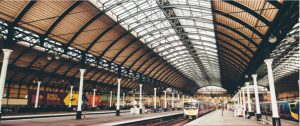
Try and arrive by train if you can, this is how Philip Larkin first arrived in the city back in 1955, and this is where our walk starts. He described it thus:
‘When your train comes to rest in Paragon Station against a row of docile buffers, you alight with an end-of-the-line sense of freedom. Outside is a working city, yet one neither clenched in the blackened grip of the industrial revolution nor hiding behind a cathedral to pretend it is York or Canterbury…Hull has its own unexpected elegances.’
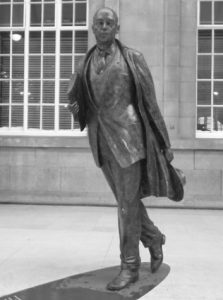 We look at the Larkin statue on the station concourse, which never quite seems to have ‘settled’ since it was erected back in 2010. It was inspired by the late leaving protagonist of Larkin’s poem ‘The Whitsun Weddings’:
We look at the Larkin statue on the station concourse, which never quite seems to have ‘settled’ since it was erected back in 2010. It was inspired by the late leaving protagonist of Larkin’s poem ‘The Whitsun Weddings’:
‘That Whitsun, I was late getting away:
Not till about
One-twenty on the sunlit Saturday
Did my three-quarters-empty train pull out,
All windows down, all cushions hot, all sense
Of being in a hurry gone. We ran
Behind the backs of houses, crossed a street
Of blinding windscreens, smelt the fish-dock; thence
The river’s level drifting breadth began,
Where sky and Lincolnshire and water meet….’
Coming out of the station, we pass The Royal Hotel (named after Queen Victoria’s visit in October 1854). Larkin was a regular customer apparently but found it a gloomy place, as he describes in ‘Friday Night in the Royal Station Hotel’:
‘Light spreads darkly downwards from the high
Clusters of lights over empty chairs
That face each other, coloured differently.
Through open doors, the dining-room declares
A larger loneliness of knives and glass
And silence laid like carpet. A porter reads
An unsold evening paper. Hours pass,
And all the salesmen have gone back to Leeds,
Leaving full ashtrays in the Conference Room.
In shoeless corridors, the lights burn. How
Isolated, like a fort, it is –
The headed paper, made for writing home
(If home existed) letters of exile: Now
Night comes on. Waves fold behind villages.’
The City Hall
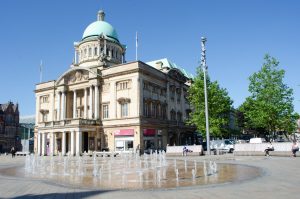 The City Hall, a purpose-built concert hall from the early 1900s, held many varied memories for Larkin. Here, under its green copper dome, he could indulge his passion for jazz, as the venue played host to many of the greats, including Count Basie, Chris Barber and Acker Bilk.
The City Hall, a purpose-built concert hall from the early 1900s, held many varied memories for Larkin. Here, under its green copper dome, he could indulge his passion for jazz, as the venue played host to many of the greats, including Count Basie, Chris Barber and Acker Bilk.
It was also fruitful for his poetry, evoking once more that feeling of isolation, as in ‘Broadcast’ when he listens on his radio to a classical concert from the City Hall. Sitting alone in his attic flat, looking out at the ‘still and withering/Leaves on half-emptied trees’, he imagines his loved one in the audience; ‘Your hands, tiny in all that air, applauding’.
Traditionally, the City Hall hosts the University of Hull’s degree ceremonies here, and when John Betjeman was awarded an Honorary Degree in 1973 it was Philip Larkin who gave the citation.
Whitefriargate/Marks & Spencer
Larkin was fascinated by what his library staff brought back from their lunchtime shopping breaks to Marks & Spencer’s, so much so that he decided to pay the store a visit. You can find a copy of the resulting poem – ‘The Large Cool Store’ – inside the shop, just by the lift on the ground floor.
‘The large cool store selling cheap clothes
Set out in simple sizes plainly
(Knitwear, Summer Casuals, Hose,
In browns and greys, maroon and navy)
Conjures the weekday world of thoseWho leave at dawn low terraced houses
Timed for factory, yard and site.
But past the heaps of shirts and trousers
Spread the stands of Modes For Night:
Machine-embroidered, thin as blouses…’
Trinity Square
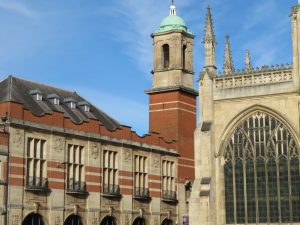 Passing the entrance to the covered market, we soon arrive in this charming square. Towards the back of the square stands the statue of Andrew Marvell, who was educated at the Hull Grammar School. He is widely regarded as one of the greatest English poets of the seventeenth century. He has many of the same preoccupations about love, the passing of time and the River Humber as Larkin, as we see in perhaps his best-known poem of all, ‘To His Coy Mistress’:
Passing the entrance to the covered market, we soon arrive in this charming square. Towards the back of the square stands the statue of Andrew Marvell, who was educated at the Hull Grammar School. He is widely regarded as one of the greatest English poets of the seventeenth century. He has many of the same preoccupations about love, the passing of time and the River Humber as Larkin, as we see in perhaps his best-known poem of all, ‘To His Coy Mistress’:
Had we but world enough and time,
This coyness, lady, were no crime.
We would sit down, and think which way
To walk, and pass our long love’s day.
Thou by the Indian Ganges’ side
Shouldst rubies find; I by the tide
Of Humber would complain. …
…But at my back I always hear
Time’s wingèd chariot hurrying near;
And yonder all before us lie
Deserts of vast eternity….’
Victoria Pier
Making our way along Nelson Street we find what remains of Hull Corporation Pier. This was the departure and arrival point for the various ferries that carried people across the estuary for seven centuries. Philip Larkin wrote about this spot: ‘The feeling of ships coming in and going out is exciting; of the door being open…’.
To the east, we follow the sweep of the estuary, and see (in Larkin’s words) the city’s ‘working skyline’ that ‘wanders to the sea’.
Looking to the west, suspended high above the estuary, we see the Humber Bridge, recently awarded a Grade I listed status. Larkin wrote a poem to celebrate the opening of the bridge in 1981, entitled ‘Bridge for the Living’:
‘And now this stride into our solitude,
A swallow-fall and rise of one plain line,
A giant step for ever to include
All our dear landscape in a new design.’
The High St
The High Street is Hull’s oldest and historically most important street and one that Larkin often walked along. It once served as a base for merchant families, such as Maister, Pease and Wilberforce, whose ships imported iron ore from Sweden and flax, grain and timber from the Baltic. Their fine houses, still here today, are connected to the large riverside warehouses by a network of narrow staithes and alleyways.
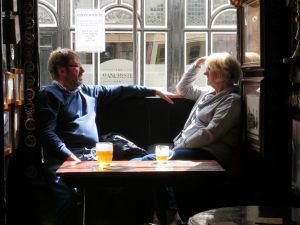 On our left, not far from the junction with Scale Lane, sits Ye Olde Black Boy, one of Larkin’s favourite pubs in the Old Town. It was here in 1977 that he gave a talk on clarinettist Pee Wee Russell and played a selection of his records to the Hull Jazz Record Society.
On our left, not far from the junction with Scale Lane, sits Ye Olde Black Boy, one of Larkin’s favourite pubs in the Old Town. It was here in 1977 that he gave a talk on clarinettist Pee Wee Russell and played a selection of his records to the Hull Jazz Record Society.
Hull History Centre
As well as containing the archives of the City Council, it also houses archives from the University of Hull. Within these sits an extensive personal collection relating to Larkin, including everything from his poetry workbooks and photographs to his enormous library of books and records.
From here (Francis St, across the dual carriageway) catch Bus 21 to Pearson Park (one runs about every 5 minutes). If you walk, it’s about half an hour.
Pearson Park
‘The centre of imaginative operations, it seems to me, is Pearson Park’, said Sean O’Brien. ‘For Larkin, public spaces, whether the rec on the estate or a Victorian park, are stages where indoors and outdoors meet and where the motives and predicaments of strangers cannot but suggest or reveal themselves. Larkin himself said: ‘Pearson Park exercises a fascination over me and I always enjoy an hour in it’.
In 1956, at the age of 34, Larkin rented a self-contained flat on the top floor of 32 Pearson Park, a three-storey red-brick house overlooking the park, previously the American Consulate. Here he lived for the next 18 years.
His green-fringed eyrie provided the ideal ambience for writing and was the starting point for poems such as ‘Toads Revisited’, ‘The Trees’, ‘High Windows’, ‘Sad Steps’, ‘Broadcast’ and ‘Vers de Société’. The poems that comprise ‘The Whitsun Weddings’ (1964) and ‘High Windows’ (1974) volumes were written here. This is an excerpt from ‘Toads Revisited’:
‘Walking around in the park
Should feel better than work:
The lake, the sunshine,
The grass to lie on,Blurred playground noises
Beyond black-stockinged nurses –
Not a bad place to be…’
We head from Pearson Park along Westbourne Avenue towards the cemetery, passing by the Nuffield Hospital (now The Westbourne NHS Centre) where Philip Larkin stayed several times as an inpatient during his final illness. He wrote to Andrew Motion in October 1985:
‘I have an uneasy suspicion that the curtain is about to go up on Act II of the Larkin drama – not well, tiresome symptoms, call in the quacks. So brush up your shovel and headstone: duties of executors.’
He died here in December 1985.
The General Cemetery of Spring Bank West
As we head back towards our start point, we stop at one of Larkin’s favourite Sunday spots, the cemetery. Its wildness appealed to Larkin, who described it to Betjeman as ‘the most beautiful spot in Hull’. When it was threatened with closure, Larkin joined others who complained and he leapt to its defence, believing it to be:
‘… a natural cathedral, an inimitable blended growth of nature and humanity over a century; something that no other town could create whatever its resources’.
Despite Larkin’s impassioned plea, the Council partially cleared the cemetery in the 1970s, but it still has plenty of character and makes you think. In Larkin’s words, ‘it gets my worries into perspective’. From an early age, Larkin was obsessed with his own mortality and many of his poems are about death – reaching a crescendo in his late masterpiece Aubade (‘Death is no different whined at than withstood’.)
So what better place to finish really than here? On a more prosaic note, we head out on the south side of the cemetery and catch a bus back from Chanterlands Avenue stop (Buses 3, 33, 44) to the Paragon Interchange (10 mins).
OTHER STUFF
Browse & Buy: Browns Books, 22-28 George Street, HU1 3AP – the main local booksellers when Larkin came to Hull.
Visit: Larkin’s grave in the Municipal Cemetery, 150 Eppleworth Rd, Cottingham HU16 5YQ
Watch: John Betjeman interviewing Philip Larkin in a 1964 episode of Monitor, https://www.youtube.com/watch?v=Coe11pgoj8E&t=1416s
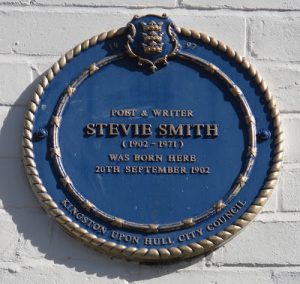 Pass By: Stevie Smith’s birthplace at 34 De La Pole Ave, HU3 6RG
Pass By: Stevie Smith’s birthplace at 34 De La Pole Ave, HU3 6RG

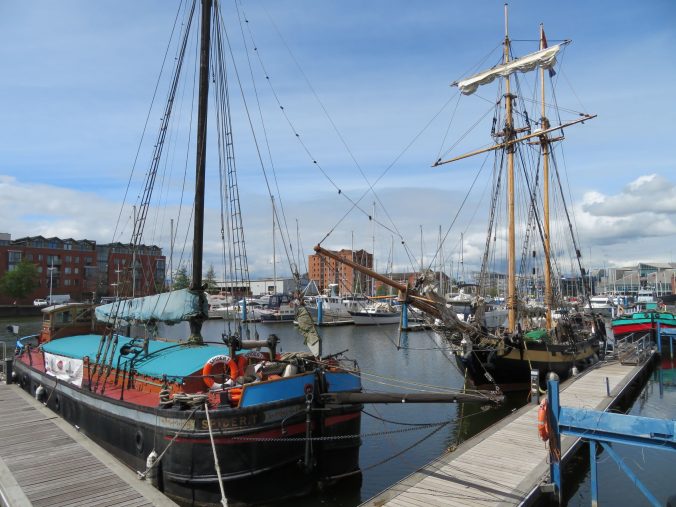

Leave a Reply